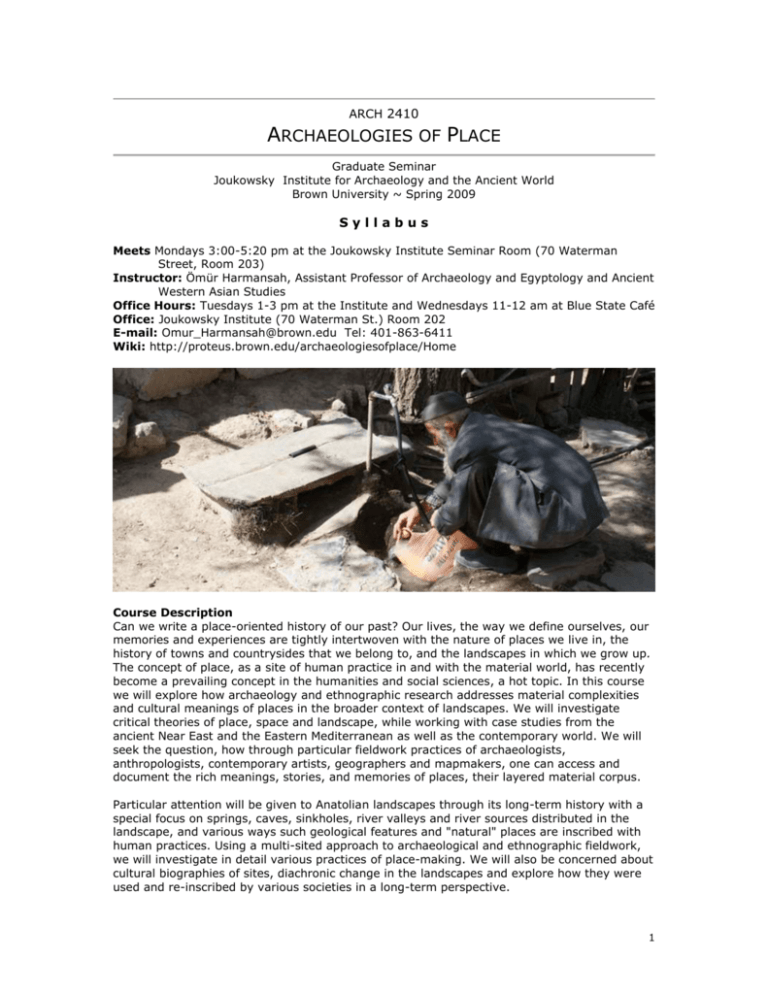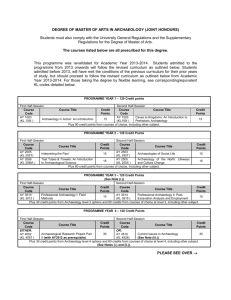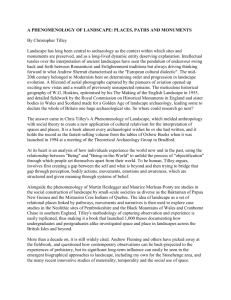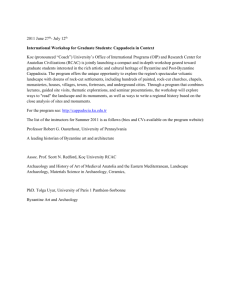Printer-friendly Syllabus
advertisement

ARCH 2410 ARCHAEOLOGIES OF PLACE Graduate Seminar Joukowsky Institute for Archaeology and the Ancient World Brown University ~ Spring 2009 Syllabus Meets Mondays 3:00-5:20 pm at the Joukowsky Institute Seminar Room (70 Waterman Street, Room 203) Instructor: Ömür Harmansah, Assistant Professor of Archaeology and Egyptology and Ancient Western Asian Studies Office Hours: Tuesdays 1-3 pm at the Institute and Wednesdays 11-12 am at Blue State Café Office: Joukowsky Institute (70 Waterman St.) Room 202 E-mail: Omur_Harmansah@brown.edu Tel: 401-863-6411 Wiki: http://proteus.brown.edu/archaeologiesofplace/Home Course Description Can we write a place-oriented history of our past? Our lives, the way we define ourselves, our memories and experiences are tightly intertwoven with the nature of places we live in, the history of towns and countrysides that we belong to, and the landscapes in which we grow up. The concept of place, as a site of human practice in and with the material world, has recently become a prevailing concept in the humanities and social sciences, a hot topic. In this course we will explore how archaeology and ethnographic research addresses material complexities and cultural meanings of places in the broader context of landscapes. We will investigate critical theories of place, space and landscape, while working with case studies from the ancient Near East and the Eastern Mediterranean as well as the contemporary world. We will seek the question, how through particular fieldwork practices of archaeologists, anthropologists, contemporary artists, geographers and mapmakers, one can access and document the rich meanings, stories, and memories of places, their layered material corpus. Particular attention will be given to Anatolian landscapes through its long-term history with a special focus on springs, caves, sinkholes, river valleys and river sources distributed in the landscape, and various ways such geological features and "natural" places are inscribed with human practices. Using a multi-sited approach to archaeological and ethnographic fieldwork, we will investigate in detail various practices of place-making. We will also be concerned about cultural biographies of sites, diachronic change in the landscapes and explore how they were used and re-inscribed by various societies in a long-term perspective. 1 Book available at Brown Bookstore You are not required to buy any of these books. We will read portions of most of them, and all are recommended readings. A copy of each of these books is placed on Reserve at the Rock. Auge, Marc; 1995. Non-places : introduction to an anthropology of supermodernity. London, New York: Verso. Tuan, Yi-Fu, 1977. Space and place : the perspective of experience. Minneapolis : University of Minnesota Press. Bradley, Richard; 2000. An archaeology of natural places. London, New York: Routledge. Massey, Doreen; 2005. For space. London: Sage. Forbes, Hamish Alexander ; 2007. Meaning and Identity in a Greek Landscape: An Archaeological Ethnography. Cambridge: Cambridge University Press. Casey, Edward S.; 1993. Getting Back into Place: Toward a Renewed Understanding of the Place-World. Bloomington: Indiana University Press. Course Requirements A wiki is created for the course to be used for discussions, posting of readings, announcements, assignments, and the like. Every student will have access to editing the wiki. Please familiarize yourself with the wiki, and make sure to check the site regularly, at least before each class meeting. You will be asked to post some of your written work on the wiki. All are expected to do weekly readings regularly and comprehensively, and contribute to seminar discussions. Participation, active involvement in the discussions, developing good note-taking habits as well as the contribution to the wiki are the most vital aspects of this course. Everyone will be occasionally asked to volunteer for short presentations in class on selected case studies of place, to be referred here as "place reports"- this may involve presenting to class specific articles, topics or a specific body of archaeological/textual material. In the first half of the semester, the written tasks will involve a series of brief commentaries and discussion pieces in relation to our theoretical discussions during the seminars. In the second half, students will focus on their research project. There will be no exams. Place reports: are designed as exercises on the variety of ways we go about understanding and deciphering everyday spatial practices. How does one go about documenting and representing what a place is all about? These documentary and representational tools may range from archaeological methods of cutting, ethnographic interviews, Geographical Informations Systsems (the infamous GIS- always with capital letters to respect the dignity of "scientific" methods), mapping, sketching, photographing, sound-recording but perhaps most importantly verbalizing, describing, visualizing. It will also allow us to think through theoretical problems with real places in mind. Grading: Class participation (30%), Commentaries and short assignments (20%) "Place reports" (20%), Final research project (30%). Research project: Every student will choose a place-related research topic in collaboration with Ömür and turn it into a final project. Collaborations with others in the seminar are always encouraged. The project should involve the theoretical concepts/issues relating to place, space, landscape and its application to an archaeological or ethnographic case study, relevant to our seminar discussions. The research project’s presentations will include a 15-20 min class presentation of the project, a 8-10 page draft (to be submitted on the day of the presentation) and a 20-25 page final paper (for graduate students- maybe shorter for undergraduates). 2 WEEKLY SCHEDULE Hidden Text (Place Bible) Heidegger, Martin; 1971. “Building dwelling thinking,” in Poetry language throught. A. Hofstadter (trans.). New York: Perennial Classics, 141-160. Week 1. (January 26) An Introduction in favour of Places, and the making of a placeworld. Leff, David K.; 2004. "Surveying" in The last undiscovered place. Charlottesville and London: University of Virginia Press, 1-40. Week 2. (February 2) Places of modernity, places in supermodernity Place reports: Starbucks, Airport terminals, Industrial ruins Appadurai, Arjun; 1996. "The production of locality," Modernity at large: cultural dimensions of globalization. Minneapolis: University of Minnesota Press, 178-199. Auge, Marc; 1995. Non-places : introduction to an anthropology of supermodernity. London, New York: Verso. González-Ruibal, Alfredo; 2008. "Time to destroy: an archaeology of supermodernity," Current Anthropology 49/2: 247-262. Week 3. (February 9) Landscape: entering the place-world Sauer, Carl; 1925. "Morphology of landscape," University of California Publications in Geography 2/2: 19-54. Ingold, Tim; 1993. "Temporality of landscape" World Archaeology 25/2: 152-174. Knapp, A. Bernard and Wendy Ashmore; 1999. "Archaeological landscapes: constructed, conceptualized, ideational," in Archaeologies of landscape: contemporary perspectives. Wendy and A. Bernard Knapp (eds.). Blackwell: Malden MA, 1-30. Rodman, Margaret C.; 2003. "Empowering place: multilocality and multivocality," in The anthropology of space and place. Setha M. Low and Denise Lawrence-Zúniga (eds.). Malden MA: Blackwell, 204-223. Hirsch, Eric; 1995. “Landscape: between place and space,” in The anthropology of landscape: perspectives on place and space. Eric Hirsch and Michael O’Hanlon (eds.); Oxford: Clarendon Press, 1-30. Casey, Edward S.; 1996. "How to get from space to place in a fairly short stretch of time: phenomenological prolegomena," in Senses of place. Steven Feld and Keith H. Basso (eds.). Santa Fe: School of American Research Press, 13-52. February 16. Long weekend: No class. Week 4. (February 23) Dreamed, imagined, storied landscapes: ethnographic accounts of the place-world Myers, Fred R.; 1986. "The Dreaming: time and space" Pintupi country, Pintupi self: sentiment, place and politics among Western Desert Aborigines. The University of California Press, 47-70. McBryde, Isabel; 2000. "Travellers in storied landscapes: a case study in exchanges and heritage," Aboriginal History 24: 152-174. 3 Basso, Keith H.; 1996. "Wisdom sits in places: Notes on a Western Apache landscape" in Senses of place. Steven Feld and Keith H. Basso (eds.). Santa Fe: School of American Research Press, 53-90. Whitridge, Peter; 2004. "Landscapes, houses, bodies, things: 'place' and the archaeology of Inuit imaginaries" Journal of Archaeological Method and Theory 11/2: 213-250. Week 5. (March 2) Archaeology of "natural" places and geological wonders: technologies of place and place-making Place Reports: Hierapolis/Pamukkale, Maya caves Bradley, Richard; 2000. An archaeology of natural places. London and New York: Routledge. Boivin, Nicole and Mary Ann Owoc (eds.); 2004. Soils, stones and symbols: cultural perceptions of the mineral world. London: UCL Press. Bender, Barbara; Sue Hamilton and Chris Tilley; 2007. Stone worlds: narrative and reflexivity in landscape archaeology. Walnut Creek, California: Left Coast Press. Dean, Carolyn; 2007. "The Inka Married the Earth: Integrated Outcrops and the Making of Place," Art Bulletin 89.3: 502–518. Brady, James E. and Keith M. Prufer (eds.); 2005. In the maw of the earth monster: mesoamerican ritual cave use. Austin: University of Texas Press. Week 6. (March 9) Anatolian landscapes: environment, archaeology, and the longterm history Place reports: Project Paphlagonia, Madra River Delta survey, Sagalassos survey Yakar, Jak; 2000. "The Anatolian landscape" in Ethnoarchaeology of Anatolia: Rural SocioEconomy in the Bronze and Iron Age. Tel Aviv University/Institute of Archaeology, 2000 Mitchell, Steven; 1993. "Rural Anatolia" in Anatolia: land, men and gods in Asia Minor. Oxford; Clarendon Press, 165-197. Gorny, Ronald L.; 1989. “Environment, archaeology and history in Hittite Anatolia,” Biblical Archaeologist 52: 78-96. Gorny, Ronald L.; 1995. “Hittite imperialism and anti-imperial resistance as viewed from Alişar höyük,” BASOR 299/300: 65-89. Glatz, Claudia; forthcoming. " Networks of interaction in Late Bronze Age Anatolia exploring Hittite imperial relationships," Journal of Anthropological Archaeology. Waelkens, Marc; 1999. " Man and environment in the territory of Sagalassos, a classical city in SW Turkey." Quaternary Science Reviews 18: 697-709 Week 7 (March 16) Rock reliefs, caves, springs and quarries: sacred places in the Hittite and Assyrian landscapes Place reports: Ivriz, Fasıllar Bonatz, Dominik; 2007. “The Divine Image of the King : Religious Representation of Political Power in the Hittite Empire” in Representations of Political Power: Case Histories from Times of Change and Dissolving Order in the Ancient Near East. Marian H. Feldman (ed.). Winona Lake: Eisenbrauns: 111-136. Barnett, R. D.; 1953. "Phrygian rock facades and the Hittite monuments," Bibliotheca Orientalis 10/3-4: 78-82. Stokkel, Peter J.; 2005. "A New Perspective on Hittite Rock Reliefs" Anatolica 31: 171-188. Gordon, Edmund I; 1967. "The Meaning of the Ideogram d KASKAL.KUR = Underground Water-Course" and Its Significance for Bronze Age Historical Geography" Journal of Cuneiform Studies 21: 70-88. 4 Harmanşah, Ömür; 2007. “Source of the Tigris: event, place and performance in the Assyrian landscapes of the Early Iron Age,” Archaeological Dialogues 14.2: 179-204. Volk, Lucia; 2008. "When memory repeats itself: the politics of heritage in Post Civil War Lebanon," International Journal of Middle East Studies, Volume 40/02: 291-314 March 21-29 Spring Break Week 8 (March 30) Fieldwork in locating places: Mediterranean style landscape surveys and methodologies of place Cherry, John F. ; 2003. "Archaeology beyond the site: regional survey and its future," in Theory and Practice in Mediterranean Archaeology: Old World and New World Perspectives. R. Leventhal and J. Papadopoulos (eds.). Los Angeles, 137-60. Alcock, Susan E. and Jane E. Rempel; 2006. “The More Unusual Dots on the Map: "Special-Purpose" Sites and the Texture of Landscape” in Surveying the Greek Chora. The Black Sea Region in a Comparative Perspective. Pia Guldager Bilde & Vladimir F. Stolba (eds.). Aarhus University Press, 27-46. Reger, Gary; 2007. "Region revisited: Identifying regions in a Greco-Roman Mediterranean context," Facta 1: 65-74. Alcock, Susan E and John F. Cherry (ed.); 2004. Side-by-Side Survey: Comparative Regional Studies in the Mediterranean. Oxford: Oxbow Books, 2004. Davis, Jack L. and Susan E. Alcock (eds.) Sandy Pylos: An Archaeological History from Nestor to Navarino. University of Texas Press. Week 9 (April 6) Ethnography and ethnohistory in landscape archaeology: Workshop with Hamish Forbes Forbes, Hamish Alexander ; 2007. Meaning and Identity in a Greek Landscape: An Archaeological Ethnography. Cambridge: Cambridge University Press. Week 10 (April 13) Site-specific/site-generated art: memory, technology and place Case studies: Ann Hamilton, Gordon Matta-Clark. Kaye, Nick; 2000. Site-specific art: performance, place and documentation. Routledge: London and New York. Kwon, Miwon; 2004. One place after another: site-specific art and locational identity. Cambridge MA: The MIT Press. Lippard, Lucy R.; 1997. The lure of the local: senses of place in a multi-centered society. New York: The New Press. Week 11 (April 20) Event of place: towards of complex understanding of archaeologies of place: fieldwork as site-specific performance Massey, Doreen; 2005. For space. London: Sage. Beck, Robin A.; Douglas J. Bolender; James A. Brown and Timothy K. Earle; 2007. "Eventful Archaeology : The Place of Space in Structural Transformation," Current Anthropology 48/6: 833-860. Week 12 (April 27) Presentation of Projects (Drafts due) Final papers due: May 8. 5








